A limited garden area doesn’t mean you can’t have a kitchen garden of your own! A Soda bottle vertical garden is one way of growing plants in small outdoor areas.
This example is very easy to make, requires very little maintenance, and will cost you next to nothing to set up!
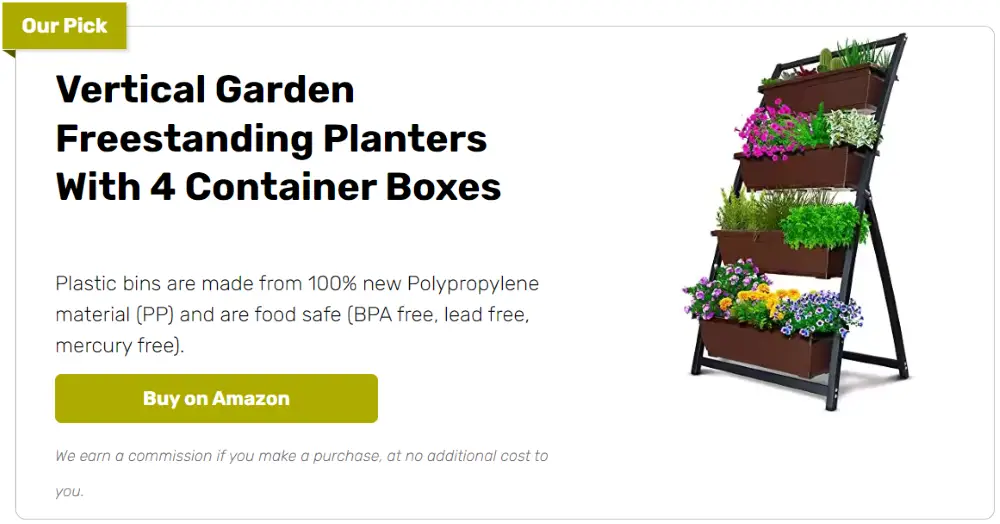
All you need are is a vertical space and some empty plastic, BPA-free liter bottles!
This vertical plastic bottle garden, or what the owner calls the ‘bottle tower’, is definitely one of the clever solutions for small space gardening. With this design, space is maximized to produce as many healthy, organic herbs and vegetables as possible with very efficient use of water. Here, almost no water evaporates and therefore it requires less watering than a regular garden.
You can grow all the herbs you want and other plants that can live in small pots in this vertical garden. It is also a nice way to grow flowers to add color to your home, such as morning glories!
It’s very cheap, easy to build, and low maintenance – what more can you ask for?
Want to learn how to build one? Just head over to the link provided below! And oh, don’t miss our album of other vertical plastic bottle garden ideas for more inspiration. :)
Contents
Building a Soda Bottle Vertical Garden
Materials
- Lots of Soda Bottles
- Plants of choice
- Sand
- Potting Soil
- Binding Wire
Tools
- Scissors
- Garden Trowel
- Cutter
Instructions
Step 1: Prepare the Soda Bottles
- Use the cutter to carefully cut the bottom off each soda bottle. The size of the opening will depend on the size of the plants you intend to grow.
- With scissors, make small drainage holes in the cap of the bottle. If the bottle will be hung upside down, these holes will allow excess water to drain. If the bottle will sit upright, remove the cap.
- Optionally, you can also cut a small window in the side of the bottle for additional planting space.
Step 2: Add Drainage Material
- Place a small amount of sand at the bottom of each bottle. This helps with drainage and prevents soil from washing out of the bottle.
Step 3: Add Soil and Plants
- Fill the bottle with a mix of potting soil and sand, leaving enough space at the top for your plant.
- Use the garden trowel to transfer your plant into the bottle. If planting seeds, follow the seed packet instructions for planting depth and spacing.
- Gently press the soil around the roots or seeds to secure them.
Step 4: Secure the Bottles
- If hanging your garden, use the binding wire to securely wrap around the neck of the bottle. Make a loop with the wire for hanging.
- For a wall-mounted garden, make holes on either side of the cut-out portion of the bottle and thread binding wire through these to create a secure loop for mounting.
Step 5: Arrange Your Garden
- Decide on the layout of your vertical garden. This could be a single column of bottles or multiple columns for a larger garden.
- Hang or mount the bottles in your chosen location, ensuring they receive adequate sunlight based on the plants you’re growing.
- Consider placing bottles at different heights to create an aesthetically pleasing arrangement.
Step 6: Watering
- Water your plants according to their needs. The small size of the bottles means soil will dry out faster, so regular checking is essential.
- Use a watering can with a long spout to target water directly to the roots, minimizing waste and evaporation.
Step 7: Maintenance
- Regularly check your plants for signs of pests or disease. The close proximity of plants in a vertical garden can sometimes encourage the spread of issues, so early detection is key.
- Prune and deadhead flowers as needed to encourage growth and maintain a tidy appearance.
Best Plants for Your Vertical Garden
Creating a vertical garden using recycled soda bottles is an innovative and eco-friendly way to beautify your living space, whether it’s a balcony, patio, or indoor area. These gardens are not only space-efficient but also offer a unique way to recycle and repurpose. However, the success of your soda bottle vertical garden largely depends on selecting the right plants that can thrive in the confined space of a bottle.
Here, we’ll explore some of the best plants for your soda bottle vertical garden, ensuring your green space is vibrant, productive, and flourishing.
Herbs
Herbs are among the most popular choices for soda bottle vertical gardens due to their compact growth habits, ease of care, and usefulness in the kitchen.
- Basil: Thrives in warm conditions and requires plenty of sunlight. It’s perfect for a sunny balcony or wall.
- Mint: Known for its vigorous growth, mint is ideal for a vertical garden as its confined space prevents it from becoming invasive.
- Parsley: Requires moderate to full sunlight and regular watering, making it a great fit for a soda bottle setup.
- Chives: With their minimal root system, chives are excellent for the limited space in soda bottles and prefer full sun to partial shade.
Leafy Greens
Leafy greens can adapt well to the confines of a soda bottle and provide fresh produce for your kitchen.
- Lettuce: A fast-growing leafy green that doesn’t require deep soil, making it perfect for a soda bottle vertical garden.
- Spinach: Known for its quick harvest cycle, spinach can grow in partial shade, making it versatile for various locations.
- Swiss Chard: With its colorful stems and tolerance for both light and semi-shade, Swiss chard adds a burst of color to your vertical garden.
Succulents and Air Plants
For those looking for lower maintenance and drought-tolerant options, succulents and air plants are ideal.
- Sedum: A hardy succulent that can thrive in the shallow soil of a soda bottle and requires minimal watering.
- Echeveria: Offers a variety of colors and shapes, perfect for adding visual interest to your vertical garden without needing frequent watering.
- Tillandsia (Air Plants): Require no soil at all, making them perfect for a soda bottle vertical garden. They absorb moisture and nutrients through their leaves and need only occasional misting.
Small Vegetables
Some small vegetable varieties can also adapt well to the space constraints of a soda bottle vertical garden.
- Radishes: With their rapid growth and small root size, radishes are ideal for the shallow confines of a soda bottle.
- Strawberries: Not only do strawberries grow well in limited soil, but their trailing habit and compact size make them perfect for vertical gardening.
- Cherry Tomatoes: While they require a bit more space, certain dwarf varieties can thrive in a larger soda bottle setup, needing staking or support as they grow.
Flowers
Adding flowers to your soda bottle vertical garden can introduce color, fragrance, and even attract pollinators.
- Petunias: Known for their vibrant blooms and ability to thrive in confined spaces.
- Marigolds: Easy to care for, marigolds can add a splash of color while also deterring pests.
- Morning Glories: With their climbing habit, morning glories can wrap around supports, adding height and lush foliage to your vertical garden.
Choosing the right plants for your soda bottle vertical garden can turn a small space into a lush, productive oasis. Whether you’re interested in fresh herbs for your culinary creations, beautiful blooms to brighten your day, or fresh vegetables right at your fingertips, there’s a plant that will thrive in your vertical garden. Remember to consider the light, water, and soil requirements of each plant to ensure your soda bottle garden is a success.
Click on any image to start the lightbox display. Use your Esc key to close the lightbox.![]()
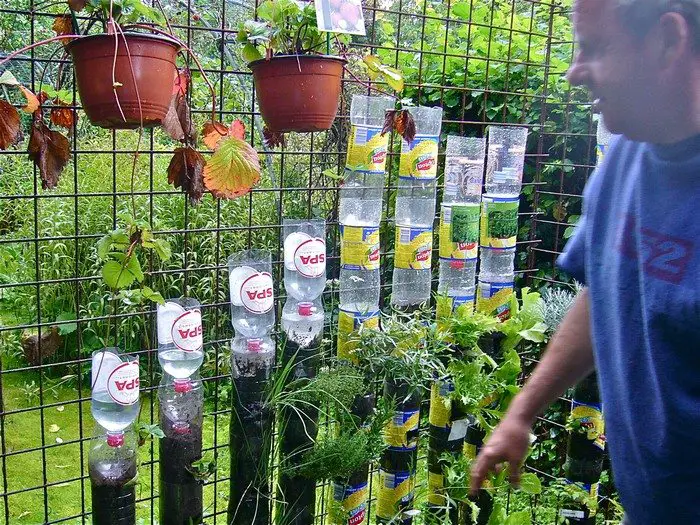
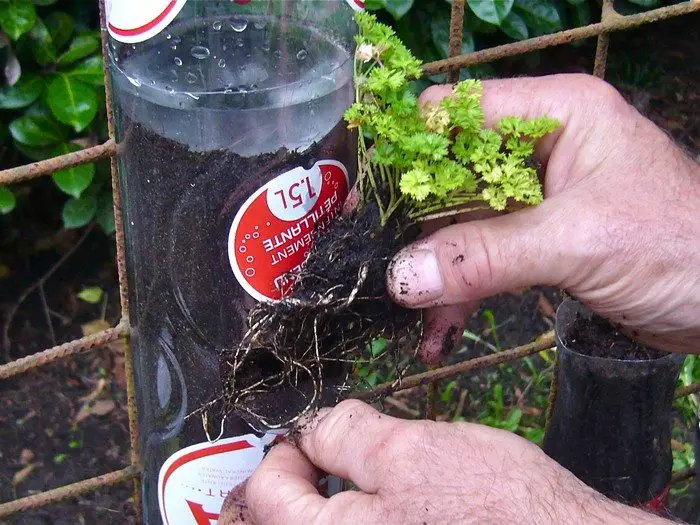
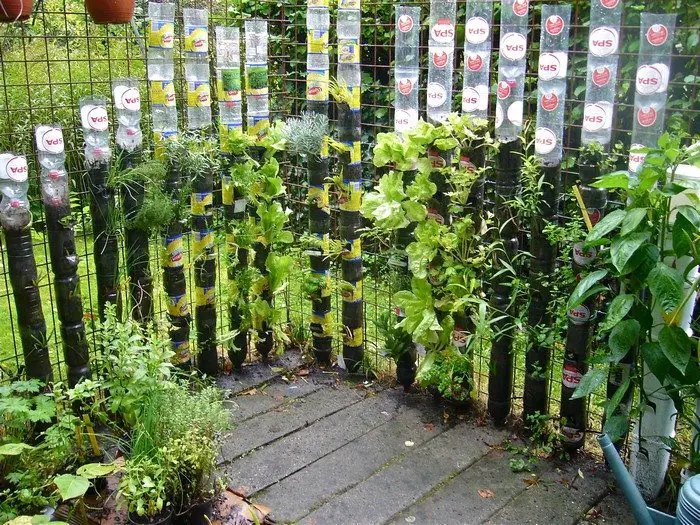
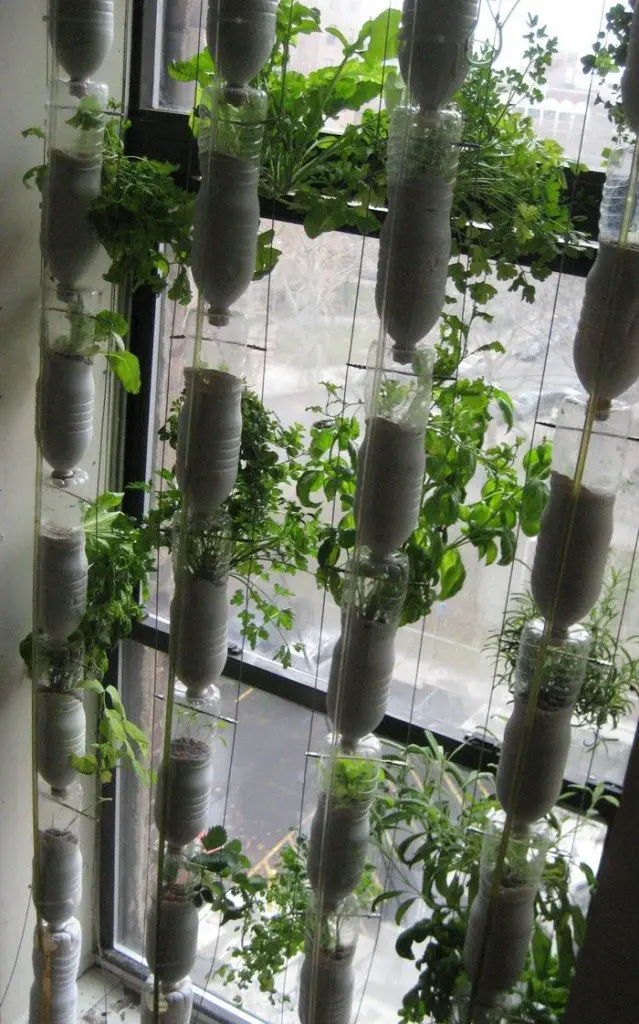
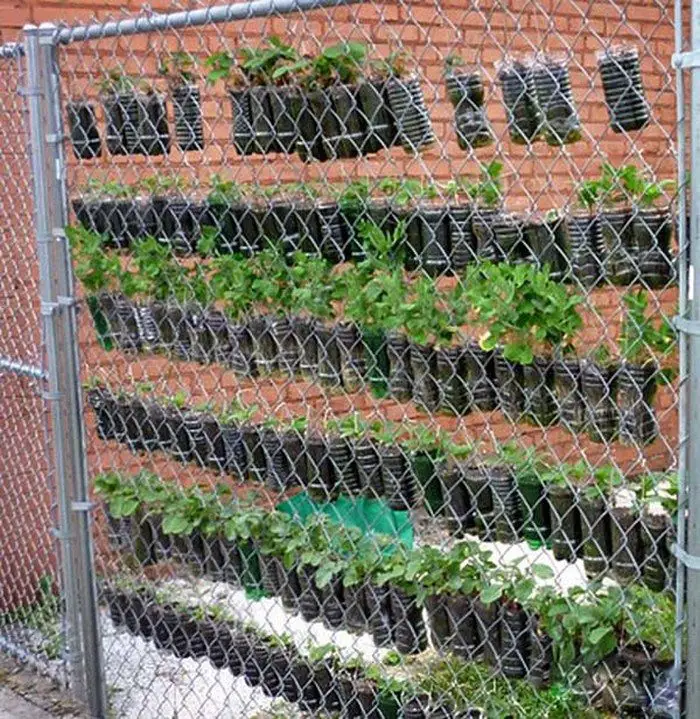
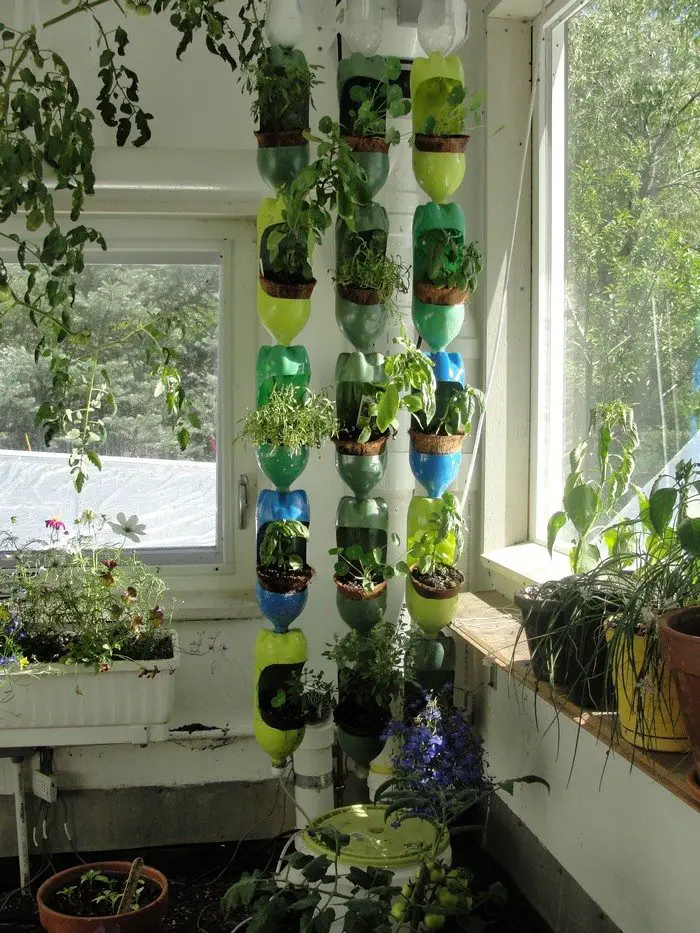

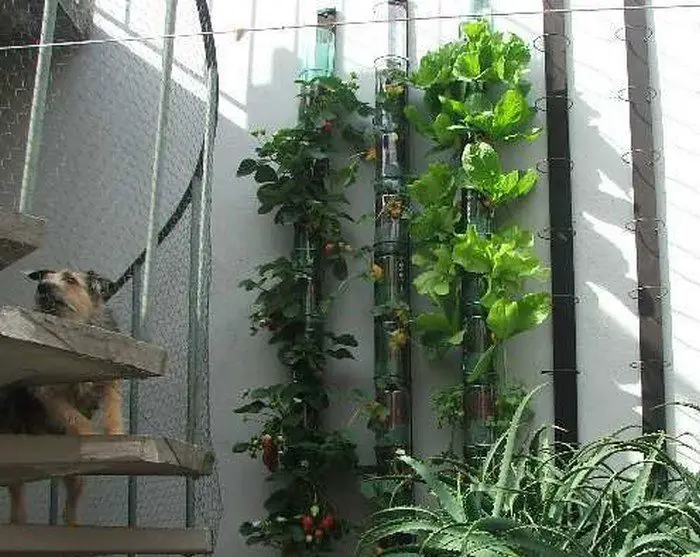
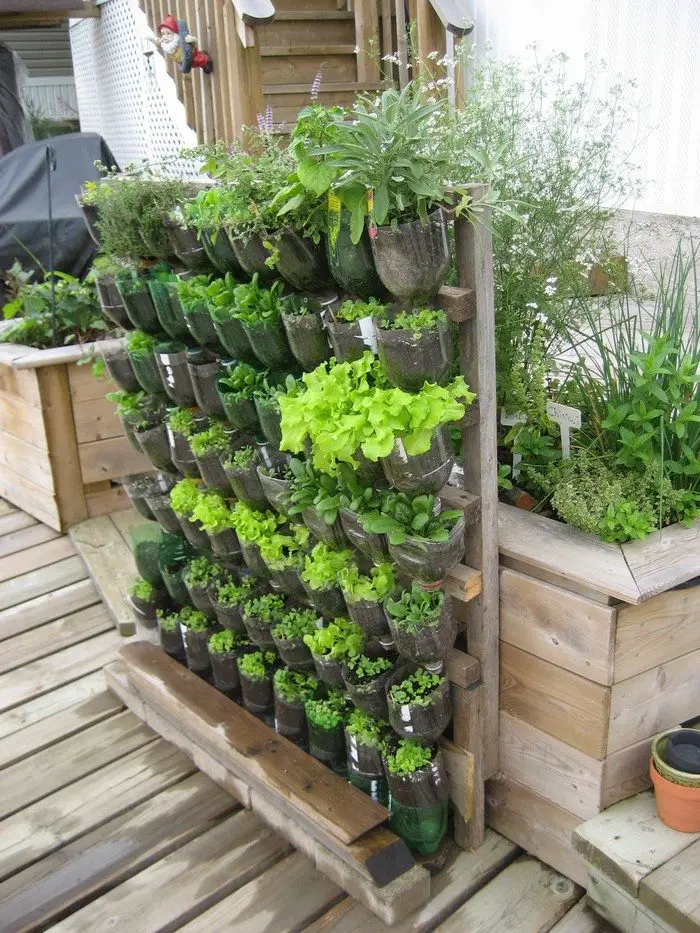
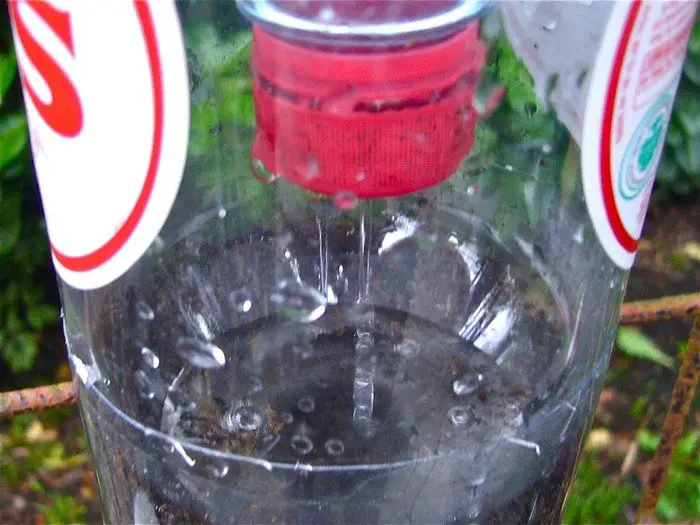


Maximizing Space and Sunlight
Maximizing space and sunlight is crucial for the success of any garden, especially when it comes to the innovative and sustainable approach of using a soda bottle vertical garden. These gardens offer a unique solution for growing plants in limited spaces, such as urban balconies, patios, or even indoor areas with sufficient light.
Here’s how to maximize space and sunlight in your soda bottle vertical garden.
Choosing the Right Location
- Sunlight Assessment: Before setting up your soda bottle vertical garden, assess the amount of sunlight your chosen area receives throughout the day. Most edible plants and flowers require at least six hours of sunlight to thrive. If your space lacks sufficient natural light, consider growing shade-tolerant plants or using grow lights for indoor gardens.
- Space Utilization: Vertical gardens are ideal for making the most of small or narrow spaces. Choose a location that maximizes unused vertical areas, such as walls, fences, or balcony railings. Ensure the structure can support the weight of your soda bottle garden once it is fully established.
Arranging Your Soda Bottle Garden
- Sunlight Orientation: Arrange your soda bottles to ensure each plant receives adequate sunlight. Place sun-loving plants at the top of your arrangement where they can get the most exposure, and shade-tolerant plants towards the bottom.
- Spacing for Growth: While one of the advantages of a soda bottle vertical garden is space efficiency, it’s important to leave enough room between each bottle for air circulation and plant growth. This prevents the spread of diseases and ensures plants can mature properly.
Creating a Sunlight-Friendly Structure
- Adjustable Systems: Consider creating a system that allows you to adjust the position of your soda bottles as the seasons change. This could be as simple as using hooks and wires that let you move bottles to optimize sunlight exposure throughout the year.
- Reflective Surfaces: If your garden area is particularly shaded, use reflective materials like mirrors or light-colored walls to bounce additional light onto your plants. This can help increase the overall light levels without direct sun exposure.
Monitoring and Maintenance
- Regular Observations: Keep an eye on your plants’ growth and health, adjusting their positions if certain areas of your garden receive more light than others. This is especially important in changing seasons when the sun’s angle shifts.
Seasonal Adjustments: Be prepared to make seasonal adjustments to your soda bottle vertical garden. As the intensity and angle of sunlight change throughout the year, so will the needs of your garden. This may involve rearranging your setup or changing out plants that are no longer thriving in the current conditions.
Watering System for Soda Bottle Vertical Gardens
Watering systems for a soda bottle vertical garden need to be efficient, space-saving, and tailored to the unique requirements of gardening in a vertical space. Each system offers distinct benefits, from simplicity and cost-effectiveness to sophisticated moisture control.
Here’s an overview of different watering systems suitable for a soda bottle vertical garden, highlighting what they are and their advantages.
1. Drip Irrigation System
A drip irrigation system for a soda bottle vertical garden involves setting up a network of narrow tubes that deliver water directly to the base of each plant. This system can be connected to a main water supply and controlled with a timer for automated watering.
Benefits:
Efficiency: Drip irrigation minimizes water waste by targeting water directly to the roots, where it’s needed most.
Time-saving: Once set up, it requires minimal intervention. A timer can automate the process, making it ideal for busy gardeners.
Reduced Evaporation: By delivering water directly to the soil, there’s less evaporation compared to surface watering methods.
2. Self-Watering Bottles
This method transforms each soda bottle vertical garden into a self-contained watering system. It typically involves creating a reservoir at the bottom of the bottle, from which water can wick up into the soil, providing a consistent moisture level.
Benefits:
- Consistent Moisture: Keeps soil evenly moist, which is crucial for seed germination and young plant growth.
- Water Efficiency: Reduces the frequency of watering by storing water and using it as the plant requires.
- Simplicity: Easy to set up with minimal materials, making it cost-effective and accessible.
3. Manual Watering with a Watering Can
For smaller soda bottle vertical gardens, using a watering can to manually water each plant can be a straightforward approach. This method involves pouring water directly into each bottle, allowing for precise control over the amount of water each plant receives.
Benefits:
- Control: Offers the ability to adjust water volume based on each plant’s needs and observe plant health closely.
- Flexibility: Easy to implement without the need for setting up any systems or equipment.
- Accessibility: Ideal for beginner gardeners or those with small setups, as it requires no special tools beyond a watering can.
4. Automated Sprinkler System
This system involves installing mini sprinkler heads at strategic points in the soda bottle vertical garden, which can be connected to a water source and controlled automatically.
Benefits:
- Uniform Watering: Ensures all plants receive water evenly, which is especially beneficial for larger vertical gardens.
- Convenience: Fully automated, saving time and effort in daily garden maintenance.
- Customizable: Can be adjusted to meet the specific watering needs of the garden, depending on plant types and climate conditions.
Choosing the right watering system for your soda bottle vertical garden depends on several factors, including the size of your garden, the types of plants you’re growing, and your daily routine.
5. Wicking System
A wicking system uses capillary action to draw water from a reservoir up into the soil, directly to the plant roots. This can be set up using a wick material, like a cotton string or rope, that extends from the bottom of the soda bottle (where the reservoir is) into the potting mix.
Benefits:
Self-Regulating: Provides a constant water supply directly to the roots, reducing the risk of under or over-watering.
Water Conservation: Minimizes water waste by ensuring only the water needed by the plant is used.
Low Maintenance: Requires less frequent refilling compared to direct watering methods, making it ideal for gardeners with limited time.
6. Rainwater Harvesting System
This system collects and stores rainwater, which can then be used to water the soda bottle vertical garden. It can involve a simple barrel to catch rain from downspouts or a more complex system with a connected irrigation setup.
Benefits:
Sustainability: Utilizes a renewable resource, reducing reliance on tap water and lowering the garden’s environmental footprint.
Plant Health: Rainwater is often softer and free of chemicals found in municipal water supplies, which can be better for plant growth.
Cost-Effective: Reduces water bills by making use of freely available rainwater.
7. Hydroponic System
Description: Hydroponics is a method of growing plants in water without soil, where all necessary nutrients are delivered directly to the plant roots via the water. In a soda bottle vertical garden, this could involve modifying the bottles to hold plants in a net cup with the roots suspended in a nutrient-rich water solution.
Benefits:
Rapid Plant Growth: The direct delivery of nutrients to roots can result in faster growth rates compared to traditional soil gardening.
Water Efficiency: The closed system recirculates water, significantly reducing usage and waste.
Space-Saving: Perfect for vertical setups, allowing for dense plantings and high yields in small spaces.
8. Micro-Drip System
A micro-drip system is a more refined version of traditional drip irrigation, designed specifically for small-scale gardens like soda bottle vertical garden setups. It involves tiny emitters that can be adjusted to release specific amounts of water directly to each plant’s root zone.
Benefits:
Precision Watering: Allows for precise control over water delivery, ensuring each plant receives just the right amount of moisture.
Adaptability: Emitters can be easily added, removed, or adjusted as the garden grows and changes.
Efficiency: Reduces water use and evaporation by targeting water directly where it’s needed.
Conclusion
Building a soda bottle vertical garden offers an innovative and sustainable way to utilize limited space for growing plants. This approach not only recycles materials that would otherwise contribute to waste but also provides an accessible method for individuals to engage in gardening and grow their own food or flowers. The myriad of customizable watering systems further enhances the efficiency and ease of maintaining a thriving vertical garden, making it an ideal choice for urban and eco-conscious gardeners.





